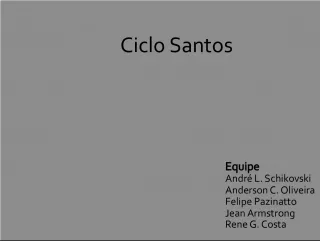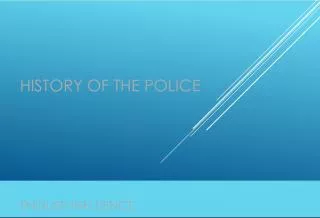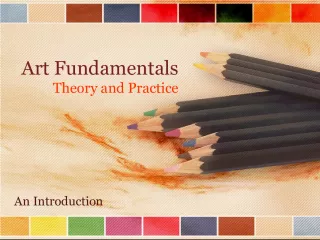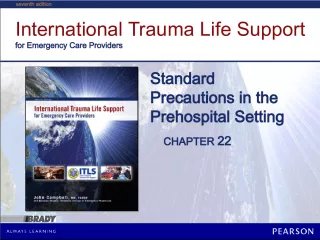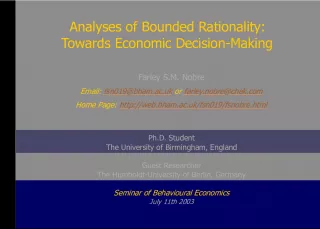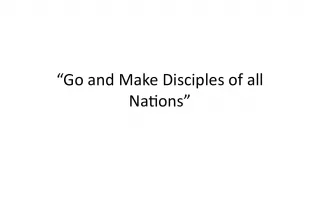The Book of Micah: An Introduction to its Setting, Scope, and Design
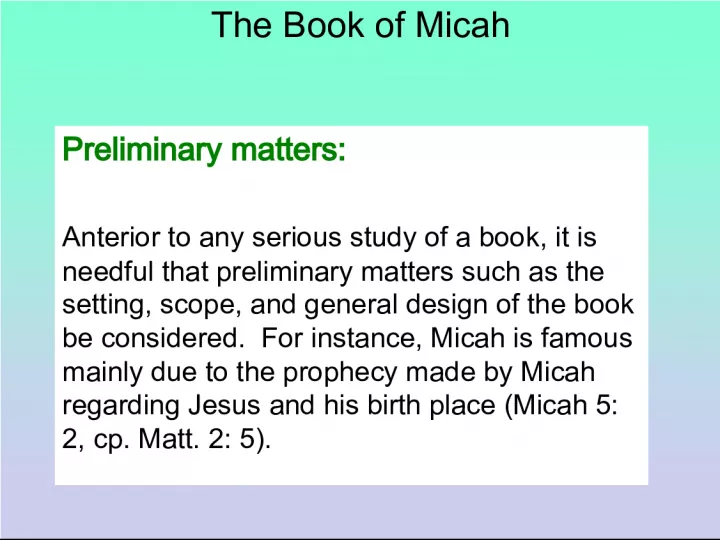

This article explores the preliminary matters related to the book of Micah, including its historical background, prophetic significance, and its famous prophecy about Jesus' birthplace.
- Uploaded on | 1 Views
-
 lilyana
lilyana
About The Book of Micah: An Introduction to its Setting, Scope, and Design
PowerPoint presentation about 'The Book of Micah: An Introduction to its Setting, Scope, and Design'. This presentation describes the topic on This article explores the preliminary matters related to the book of Micah, including its historical background, prophetic significance, and its famous prophecy about Jesus' birthplace.. The key topics included in this slideshow are Micah, book, preliminary matters, setting, scope, design, prophecy, Jesus, birthplace,. Download this presentation absolutely free.
Presentation Transcript
2. The Book of Micah Preliminary matters: Anterior to any serious study of a book, it is needful that preliminary matters such as the setting, scope, and general design of the book be considered. For instance, Micah is famous mainly due to the prophecy made by Micah regarding Jesus and his birth place (Micah 5: 2, cp. Matt. 2: 5).
3. The Book of Micah 2: But thou, Bethlehem Ephratah, though thou be little among the thousands of Judah, yet out of thee shall he come forth unto me that is to be ruler in Israel; whose goings forth have been from of old, from everlasting (Micah 5).
4. The Book of Micah Three sections of this work represent three natural divisions of the prophecy -1, 2; 3-5; 6,7- each commencing with rebukes and threatening and closing with a promise. The first section opens with a magnificent description of the coming of Jehovah to judgment for the sins and idolatries of Israel and Judah, ch. 1:2-4, and the sentence pronounced upon Samaria, vs. 5-9, by the Judge himself. The sentence of captivity is passed upon them. (Micah 2: 10) but is followed instantly by a promise of restoration and triumphant return. (Micah 2: 12, 13.).
5. The Book of Micah The second section is addressed especially to the princes and heads of the people: their avarice and rapacity are rebuked in strong terms; but the threatening is again succeeded by a promise of restoration.
6. The Book of Micah In the last section, chs. 6, 7, Jehovah, by a bold poetical figure, is represented as holding a controversy with his people, pleading with them in justification of his conduct toward them and the reasonableness of his requirements. The whole concludes with a triumphal song of joy at the great deliverance, like that from Egypt, which Jehovah will achieve, and a full acknowledgment of his mercy and faithfulness of his promises. vs. 16- 20.
7. The Book of Micah The last verse is reproduced in the song of Zacharias. (Luke 1: 72, 73.) Micahs prophecies are distinct and clear. He it is who says that the Ruler shall spring from Bethlehem. (Luke 5: 2.) His style has been compared with that of Hosea and Isaiah. His diction is vigorous and forcible, sometimes obscure from the abruptness of its transitions, but varied and rich ( Smiths Bible Dictionary ).
8. The Book of Micah The date of Micah. Based on Micah 1: 1, Micah appears to have been active for about 60 years (perhaps mainly 16, between 757 and 697 (Jotham began to reign and Hezekiahs death).
9. The Book of Micah Important, relevant dates: The Assyrians captured Samaria in 722 (cp. Micah 1: 6). In 606, the first groups of Judaeans were taken to Babylon as captives. Jerusalem captured by Babylon in 597 (cp. Micah 4: 100). Jerusalem fell in 586 (cp. Micah 3: 12). First group returned in 536. Walls of Jerusalem rebuilt in 444 (cp. Micah 4).
10. The Book of Micah Micahs prophecies: Micah specifically prophesied regarding the destruction of Samaria (Micah 1: 5, 6). Micah also prophesied of the fall of Jerusalem about 150 years before and provided the name of the conquering kingdom before this kingdom was considered to possibly be such a threat (cp. 4: 10).
11. The Book of Micah Micahs prophecies (continued): Even in view of the total control of Babylon and utter destruction of Jerusalem, Micah prophesied of the rebuilding and restoration of Jerusalem (cp. 3: 12, etc.). It would appear, though, that in the main, Micahs prophesies relative to restoration were Messianic and spiritual in nature (cp. 4: 1f., cp. 2: 12, 13).
12. The Book of Micah Section one (chapters 1 and 2). 1. The Judgment of God (1: 2-4). A. Samaria not overlooked (1: 6, 7). B. Particular sins specified (2: 1-11, 7). 2. Promise of restoration (2: 12, 13).
13. The Book of Micah Section two (chapters 3, 4, 5). 1.The heads of the people are addressed and especially held accountable (3: 1, cp. Heb. 13: 17). 2. Particular sins of these leaders (3: 2, 3, 4, 9, 10). 3. The teachers are addressed (3: 5, 11).
14. The Book of Micah Section two (chapters 3, 4, 5), contd. 4. The destruction of Jerusalem and restoration (3: 12, 4: 1-2). 5. Babylon is named as the invading Kingdom (4: 10). 6. In keeping with Micahs style, immediately restoration is again presented (5: 1, 2).
15. The Book of Micah Section three (chapters 6 and 7). 1. God challenges his people (6: 1, cp. Amos 4: 12). 2. They are urged to remember Gods mindfulness of them (6: 3-5). 3. Israel, both realistically and ideally is presented (7: 1-7).
16. The Book of Micah Conclusion: Notwithstanding the many infractions of Gods people, He remains longsuffering and willing to forgive (Micah 7: 18-20, cp. 2 Peter. 3: 9).

